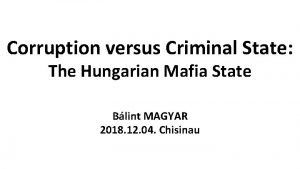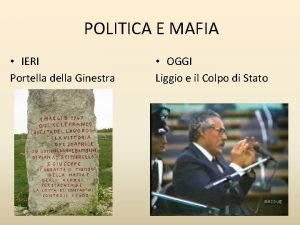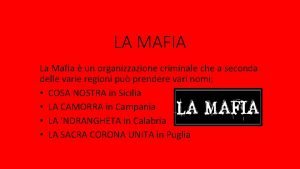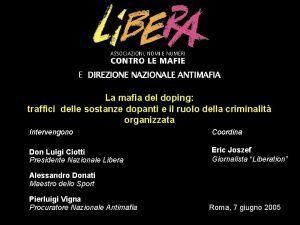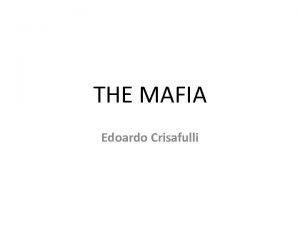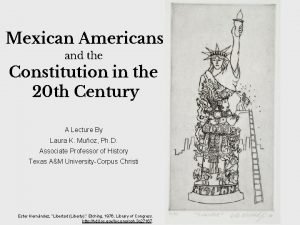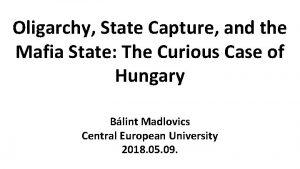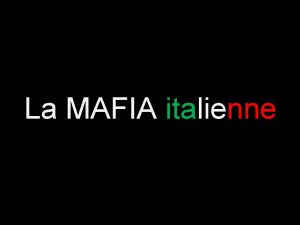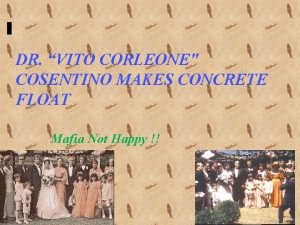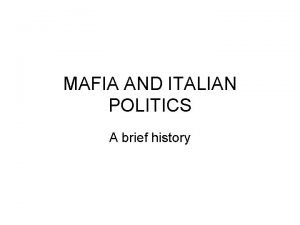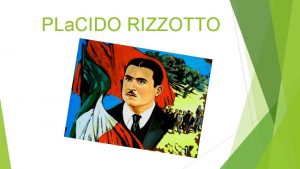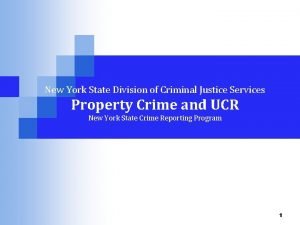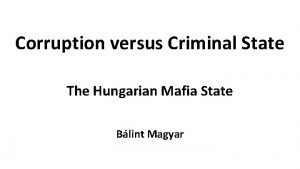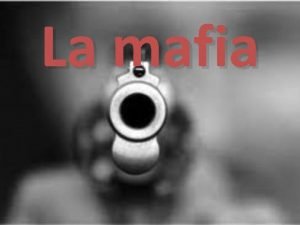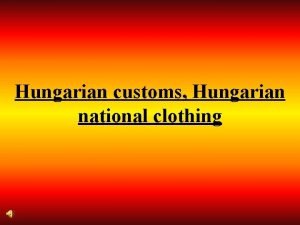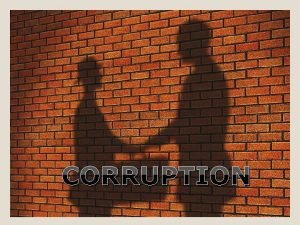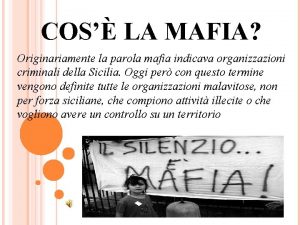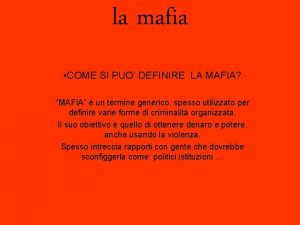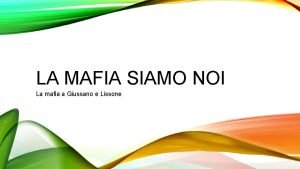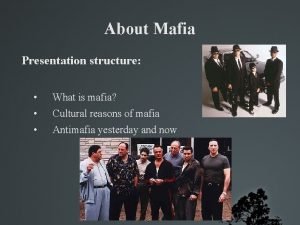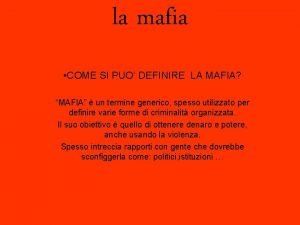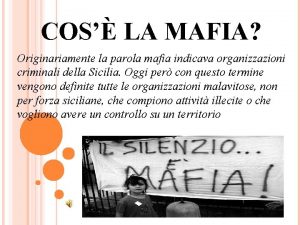Corruption versus Criminal State The Hungarian Mafia State


















- Slides: 18

Corruption versus Criminal State: The Hungarian Mafia State Bálint MAGYAR 2018. 12. 04. Chisinau

Stubborn structures of post-communism leading to autocratic regimes Ø the lack of proper separation of the three spheres of social action (political, market, communal) (Claus Offe); Ø collusion of power&ownership (Andrey Ryabov); Ø patrimonialization: private appropriation of the public authority (Max Weber, Oleksandr Fisun); Ø patron-client relations (Henry Hale); Ø centralized and monopolized forms of corruption.

Main Corruption Patterns in the Post-Communist Region Regularity and Petty corruption Oligarchic state capture Party state capture Criminal state Direction of corrupt action Distribution of corrupt transactions Spread of corruption Form of corrupt networks Economic nature of corruption Character of corrupt transactions Bottom-up Noncentralized Nonsystemic or systemic n. a. Competitive Voluntary Ad hoc and partial Kickback money Bottom-up Moderately centralized Nonsystemic or systemic Parallel verticals Oligopolistic / locally monopolistic Coercive Temporary / permanent and partial Kickback money Top-down Partially centralized Nonsystemic or systemic Parallel verticals Oligopolistic / locally monopolistic Coercive Permanent and partial (vassal chains) Protection money Systemic Single vertical Coercive Permanent and general (vassal chains) Protection money Top-down Centralized Monopolistic scope of corrupt transactions Medium of corrupt exchange

Patterns of corruption in three ideal-type political regimes Liberal democracy Post-communist patronal autocracy Communist regime surplus corruption sellers’ corruption n. a. shortage corruption buyers’ corruption competitive market corruption system destroying corruption generally/normatively sanctioned relational market corruption administrative market corruption system lubricating corruption system constituting corruption selectively preferred (крыша, „roof”) or sanctioned moderately tolerated

Types and some features of reiderstvo in post-communist regimes Strength of the state „Legiti-macy” of raiding Strong state White raiding I I I Gray raiding I I Weak Black raiding state The initiator or client of the corporate raiding Organized upperworld: Low or middle level chief patron (top level public authority) XXXXXXXXXXXXXXXXX Criminal state Institutional environment Single-pyramid and features of the raiding patronal system Monopolized action Market and oligarch capture Rival entrepreneurs or oligarchs Organized underworld: criminal groups XXXXXXXXXXXXXXXXX XXXXXXXXXXXXXXXXX XXXXXXXXXXXXXXX State crime Corporate crime Crime Multi-pyramid patronal system Oligarchic Partial state capture Competitive

Patronage Politics: State Functions Subordinated to Private Interests: the Post-Communist Mafia State The basis for the Alternative terms used for the term used description of patronage in postcommunist regimes 1. Actor 2. Action (targeting power) 3. Action (targeting goods) 4. Legality clan state neopatrimonial state predatory state criminal state Post-Communist Mafia State

Criminal State = Mafia State Classic Mafia: the organized criminal underworld led by a chief patron (fighting/corrupting public authorities) Mafia state: the organized criminal upperworld, when a political enterprise becomes an economic one, the governance operates like a criminal organization. It is a privatized form of a parasite state. Not oligarchs capture the state but a political enterprise captures the oligarchs and the economy. The new ruling elite: the adopted political family. The chief patron’s power of enforcement works at a national level. The post-communist Mafia state is not merely a deviant form of liberal democracy, nor is it a transient formation, rather it is an independent subtype of autocracy.

Need for big data evidence The Case of Hungary Corruption Research Center Budapest (István János TÓTH)

Corruption risk at the public procurements in Hungary between 2009 and 2015 (N: 118. 843; source CRCB 2016) (Corruption risk index: 0 = if there is competition and public notice; 0, 5 = if one of them is missing; 1 = if both of them is missing) 0. 6 0. 55 0. 45 EU Funds Non-EU Funds 0. 4 0. 35 0. 3 0. 25 0. 2 2009 2010 2011 2012 2013 2014 2015

Share of public procurements without public notice in Hungary between 2009 and 2015 (%) (N =121. 849; source: CRCB 2016) 70 60 50 40 30 20 10 0 2009 2010 2011 2012 2013 2014 2015

The change of overpricing in Hungarian public procurements between 2009 and 2015 (N = 123, 224; source: CRCB 2016) 8 7 6 5 4 3 2 1 0 2009 2010 2011 2012 2013 2014 2015 (The mean squared error (MSE) of contract prices of Hungarian Public Procurements from theoretical (Benford’s) distribution by year, first digits, 2009 -2015, N = 123, 224)

Public Perception of Criminal State The Case of Hungary Medián Public Opinion Research Institute (Endre HANN, December 2017)

Petty corruption or grand corruption The distribution of respondents according to their party-sympathy (%) (Source: Medián Public Opinion and Market Research Institute, December 2017) 85 90 80 74 67 70 60 Ocassional private action of dishonest public servants 59 50 40 33 30 22 21 20 14 10 0 Fidesz (rightwing government party) Leftwing, green, liberal Jobbik (extreme opposition parties rightwing opposition party) Undecided Centrally, systematically organized action from above

How likely is that the prime minister gets richer via front men and stooges? The distribution of respondents according to their party-sympathy (%) (Source: Medián Public Opinion and Market Research Institute, December 2017) 90 82 80 65 70 60 45 50 38 40 29 30 20 Very likely 51 29 28 Likely 13 5 10 0 Fidesz, rightwing governing party 7 0 Out of question Leftwing, green, liberal Jobbik, extreme Uncertain opposition parties rightwing opposition party (The question: In your opinion, is it likely that István Garancsi, Lőrinc Mészáros or Andy Vajna are the front men or stooges of Viktor Orbán, and the significant part of their huge business profit is channeled to the Prime Minister? )

Definition of the present Hungarian political regime The distribution of respondents according to their party-sympathy (%) (Source: Medián Public Opinion and Market Research Institute, December 2017) 100% 8 90% 80% 21 70% 3 3 5 4 3 6 9 8 20 18 17 4 12 11 49 28 0% Illiberal democracy Autocratic regime 30 30% 10% Western democracy 30 40% 20% System of National Cooperation (Self-definition of the gov. ) 7 60% 50% Does not know Mafia State 7 3 2 Fidesz (rightwing government party) 31 29 17 2 3 Leftwing, green, liberal Jobbik (extreme rightwing opposition parties opposition party) 1 Undecided Dictatorship Fascistoid regime

Features of the Hungarian Mafia State – in 9 Points The Hungarian state § a mafia state: a business venture managed through the monopoly of instruments of public authority; Actual decisionmakers § the chief patron (Viktor Orbán) and his court: an informal body of leadership; Fidesz, the “ruling party” § transmission belt party: no decision-making, just mediating and formalizing the wishes of the informal network; Ruling elite § adopted political family: a single-pyramid patronal network (extended patriarchal family, clan) lacking formal structure and legitimacy; Dominance structure § single pyramid patronal network: a centralized chain of command built on a patron-client network of vassalage; Economic activity of the state § rent-seeking, cleptocracy and centrally-led corporate raiding: wealth accumulation and patronalization of private property through the bloodless instruments of state coercion; Corruption § criminal state: top-down system constituting, centralized and monopolized corruption, committing criminal acts according to current criminal code; Motives of the rulers § power and personal wealth: accumulation of power for wealth and vice versa; Orbán’s “populism” and “nationalism” § ideology-applying regime: cynic and “rational” (Edward C. Banfield: “amoral familism”)

Hungarian Mafia State = Orbanized crime

Thanks for your attention.
 Hungarian mafia
Hungarian mafia Mafia hula hoops
Mafia hula hoops Mafia ieri e oggi
Mafia ieri e oggi Cosa è la mafia
Cosa è la mafia Don diana
Don diana Doping e mafia
Doping e mafia Studymafia
Studymafia Edoardo crisafulli
Edoardo crisafulli No mexicans allowed
No mexicans allowed Mafia states of america
Mafia states of america Morte alla francia italia anela
Morte alla francia italia anela Mafia italienne
Mafia italienne Cosentino mafia
Cosentino mafia Mafia
Mafia Giuseppe letizia la mafia uccide solo d'estate
Giuseppe letizia la mafia uccide solo d'estate Nys division of criminal justice services
Nys division of criminal justice services Sexting laws in ct
Sexting laws in ct Public health internships ct
Public health internships ct Traditional hungarian costume
Traditional hungarian costume
